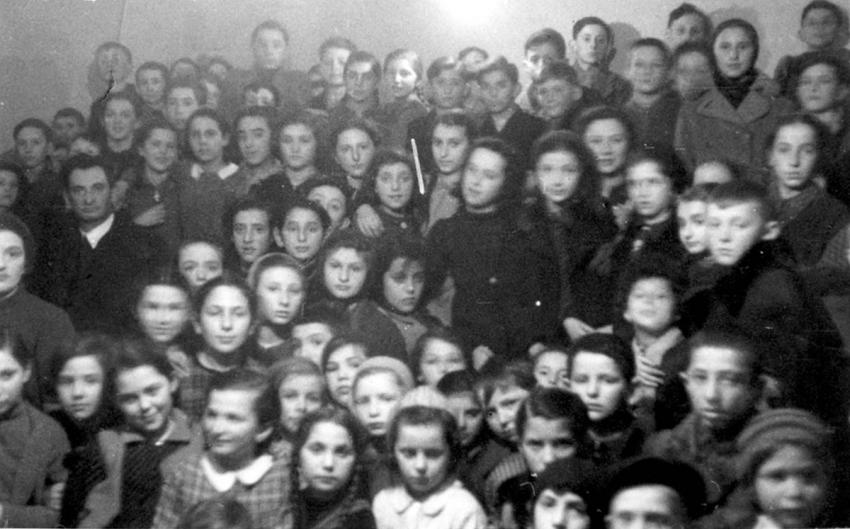Before the Holocaust, some 2,500 Jews live in Bochnia, in southwest Poland. A ghetto was established in the town in March 1941, where Jews from Bochnia and the surrounding towns were confined. In the summer and fall of 1942, most of the ghetto's Jews were deported to the Belzec extermination camp. Several hundred, mainly women and children, were murdered in the nearby forest.
Bochnia is situated approximately 45 km southeast of Krakow. After World War I, some 2,500 Jews lived there, constituting about a quarter of the city’s population. Bochnia’s Jews made a living in trade, craftwork and industry. There were welfare and charity organizations in the town, and a medical clinic. The Jewish children attended Heder, Talmud Torah and a "Tarbut" school, where they studied in Hebrew. Zionist parties and youth movements were active in Bochnia, and also established Hachshara (pioneer training) schemes attended by dozens of idealistic youngsters. In addition, there were branches of Agudat Israel and the Bund in the town.
On the eve of World War II, refugees from Germany and Czechoslovakia arrived in Bochnia, and were supported by the local community.
On 3 September 1939, the Germans occupied Bochnia, and immediately started to take Jews away for forced labor. Many Jewish families were evicted from their homes, which were made available for use by German officers and bureaucrats. Jewish shops were looted, and Jews were forced to pay heavy fines. Despite these hardships, Jews in Bochnia attempted to continue their lives. With optimism and faith in a better future, they organized welfare agencies, opened a clinic and even established a soup kitchen.
In late 1939, a Judenrat was appointed, responsible for providing workers as per German demands, but Jewish youngsters were still snatched off the streets for forced labor.
In March 1941, a ghetto was established in Bochnia. The overcrowding and hunger were severe, and Jews who worked outside the ghetto smuggled food in, despite the threatened punishments of imprisonment or deportation to labor camps.
Frieda Schiff Frankel came to Bochnia in early 1941 at the age of 11, and was incarcerated in the ghetto there. In her testimony, she recalls:
"In the ghetto, the adults went out to work. We all went out to work. Those who didn't work did not have the right to exist in the ghetto. We were very happy that although we were such young children, they accepted us for work…
We lived in very cramped conditions, several families together. We divided ourselves up into those families who watched over the children and those who went out to work. We went out to work in two shifts. We received bread, but nothing else… we had money so we had the chance to supplement our food rations.
Jews returning from work would sometimes smuggle food into the ghetto, flour… Before Passover, they smuggled in some eggs. We had an oven, and grandpa used to stand and watch how we peeled potatoes, in case heaven forfend too much would be peeled off. Until today, I cannot bear to look if someone peels off too much."
From July, leaving the ghetto was forbidden, and from October, unauthorized departure from the confines of the ghetto was subject to the death penalty. However, until spring 1942, the ghetto population expanded as the Nazis forced refugees to join. Despite the inflated population, the Germans did not permit the entry of additional food, and living conditions deteriorated. Some Jews with a level of immunity due to having foreign citizenship, tried to preserve connections with the outside world, assisted in the smuggling of food into the ghetto, and tried to hide or even smuggle out children.
In August an Aktion took place in the Bochnia ghetto. Most of the ghetto’s inhabitants - some 5,000 Jews - were deported to the Belzec death camp. A further 500 were shot in the nearby forest, and those found hiding were murdered on the spot.
After the Aktion, the ghetto area was reduced. In November 1942, Jews who didn’t have work permits, and women and children were deported from Bochnia to Belzec. The hospital patients were murdered there and then, as was part of the medical staff. In the same month, hundreds of Jews still remaining in the surrounding communities were brought to Bochnia, and the ghetto took on the form of a labor camp. In August and September 1943, the last Jews of Bochnia were sent to the Trzebinia and Plaszow camps. On 1 October 1943, Bochnia was declared “Judenrein” – cleansed of Jews.
Yad Vashem Photo Archives, 71BO5

